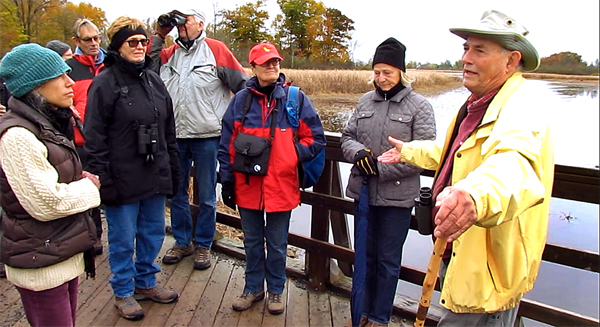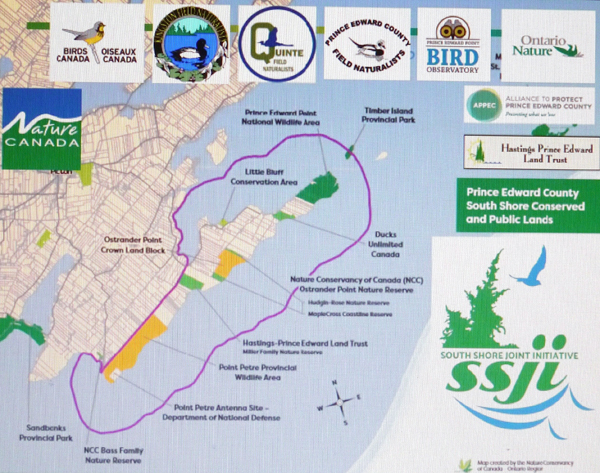Nature’s future in today’s hands: Terry Sprague
Administrator | Jan 21, 2021 | Comments 0

Tina Sawicki photograph of Terry Sprague and his beloved pup Christie.
By Sharon Harrison
Prince Edward County naturalist Terry Sprague spoke about his lifetime as an interpretative naturalist this week during a light-hearted conversation with radio host, writer and botanical painter Pamela Stagg.
Continuing its free webinar series, the South Shore Joint Initiative (SSJI) welcomed more than 50 participants to hear Sprague’s thoughts on a variety of related nature topics.
He has held positions at the Glenora Fisheries Station and was an interpretive naturalist at Sandbanks Provincial Park for eight years, working for Quinte Conservation for 17 years, as well as being the recipient of various conservation awards.
Sprague spoke to how his experiences can be applied to teaching nature and conservation today, as he told the story of why his work, even in retirement, has always been something he enjoyed doing and he continues to learn new things every day.
“You have educated and inspired generations of folks in the County, and it doesn’t look like you show any signs of stopping anytime soon,” said John Hirsch, SSJI president.
On a more serious note, Sprague shared his view on the overuse and abuse of Sandbanks Provincial Park, and expressed concern with the number of visitors the park now gets.
“Sandbanks is really in danger of drifting into West Lake if we don’t be careful, and somehow control the masses of visitors,” he said, noting that when he worked there, 300,000 visitors in a season was considered a busy year.
“Those numbers have jumped to 700,000-800,000 people per year for the past seven to eight years, and that is really too many. How much more pressure can you put on a sensitive environment before something terrible begins to happen?”
Sprague hopes for continued pushing, to drive the message home that “if we lose what we’ve had, we are never going to get it back. We need to get past this mindset that it is all about revenue.”
Sprague says he has been interested in conservation and nature since he was a small boy growing up on the Big Island family farm, then progressing to teaching about it.
“It has been a wonderful, wonderful lifetime for me.”
Stagg asked what had caught his attention about the natural world.
“Every farmer is interested in nature to some degree, but for me it went a little bit further,” he said. “I had this need to take it one step further, to learn what these plants and animals and birds were that I was looking at,” why the plants and birds and animals were there and what they were doing.
He fondly spoke of his Grades 6-8 teacher who fostered his interest in nature.
“She would tell us all these stories about birds coming to her hand, and we’d all be gathered around.”
He adds that while some of the kids weren’t interested in what was going on, he was, and stayed to listen to her stories, which developed into meaningful conversations.
He admits his interest in birds and bird-watching subsided during his high school days because it wasn’t something cool to admit to in front of classmates; then met his sixth grade teacher again after high school. Visiting her home in nearby Northport, Sprague says he was hooked when he saw plenty of purple finches at one of her bird feeders.
Sprague began writing nature columns in December 1965 for the Picton Gazette, resulting in more than 6,200 columns over 50 years. He retired his column just a few years ago.
Stagg asked what it was like switching from learning about nature, to teaching others about nature.
“My life was just getting better and better all the time every year,” Sprague said, noting after five years at Glenora Fisheries, he took the position of assistant park naturalist at Sandbanks, a position he held for eight summers.
“I think it was here that I realized that I knew enough about nature that I could teach what I knew, and learn the rest as I went along.”
He notes he was nervous when he first started but quickly realized many people who came to Sandbanks didn’t often get out of an office environment – their careers were their whole life – so everything he told them was brand new information.
“It was a great experience to be able to instill an interest in them about the park and the natural and cultural history of the park and how important it was to preserve it. My whole goal was they would learn a little more than what they initially knew when they came here and that was very satisfying.

Two dozen people explored sections of Prince Edward County’s Millennium Trail during a wetlands safari hosted by naturalist Terry Sprague, right. – Sue Capon photo
Sprague said his dream job was at Quinte Conservation, then Prince Edward Region Conservation Authority, working at Macaulay Mountain where he learned many new and interesting things, offering programming, talks and hikes.
“I did that for 15 years or so and the program just got bigger and bigger, something I was doing by myself.”
Stagg noted how Sprague took the giant step of going off on his own to start his own business, (Nature Stuff Tours) and that he must have thought there was enough interest in nature to sustain the business.
“The one benefit of doing the programs on my own was now I was able to expand them and do some really wonderful locations. There are so many natural areas and we never did really get a chance to explore everything.”
While working under his own steam, Stagg noted he taught courses, acted as a guide for bus tours, wrote articles, maintained a website, led hikes, and is still leading hikes.
She asked what topics were the most interesting to his audiences.
“Birds probably, because that’s my strength and it tends to interest most people and they always generate a big audience.” His workshops on bird identification always had 25-30 people attending.
Stagg spoke to the changing face of Prince Edward County in terms of new people moving in from the city who know nothing, or very little about nature and questioned how to continue reaching and teaching people about conservation and nature to preserve Prince Edward County’s natural environment.
Sprague noted the importance of continuing work through organizations that focus on nature.
“If we expect to see and enjoy nature tomorrow, we must enjoy and protect it today. We must protect not only the animals and the plants, but their habitat as well.”
 A question and answer period from the audience followed.
A question and answer period from the audience followed.
One person asked how the challenges of protecting fragile areas and bringing people to learn about them can be balanced, citing Sandbanks and Little Bluff as examples.
“I don’t know what the answer is, but we do have a serious situation in Prince Edward County, and this is going to be a continuing problem as our area continues to be discovered,” he said. “There has to be some way to control them in a very sensitive manner, so that all can enjoy what we have here in a more controlled fashion.”
Another asked about McMahon Bluff, its future and appropriate accessibility.
“There has to be controlled access because it’s pointless to set aside these special areas that have never before seen many people, then suddenly open them up to throngs of people.”
He noted McMahon Bluff is a mesa (a steep flat-topped hill like a table top) and the only mesa in the area with some very special vegetation.
In answer to a question on next steps to protect the County’s south shore, Sprague stated no building must be allowed.
“It is a special place and I’ve done birding and nature study over most of that area; it’s very remote and we hope to keep it remote.”
“When I was growing up, the south shore was just a desolate place and there was no interest in it. Today there is and that’s wonderful.”
Spanning 26 kilometres, the South Shore Important Bird and Biodiversity Area is Canada’s largest and last undeveloped Lake Ontario natural landscape and shoreline.
“We are advocating for all the South Shore IBA public lands to be conserved and safeguarded from development and protected by management plans, established with public input,” Hirsch said.
He said the SSJI members are very proud that on Sept. 10 last year the Minister of the Environment announced the government’s intention to make Point Petre Provincial Wildlife Area and Ostrander Point Crown Land Block a conservation reserve.
“Because it was announced doesn’t mean this area will necessarily become a reserve – it’s being studied by the province,” Hirsch reminded. “These areas are still under threat and continued public engagement and advocacy work is needed to ensure that the south shore will be permanently protected for future generations.”
For more information on the South Shore Joint Initiative, visit ssji.ca
The presentation is available for viewing on the South Shore Joint Initiative’s new YouTube channel.
Visit Terry Sprague’s Nature Stuff website at http://naturestuff.net/site/
Filed Under: Featured Articles
About the Author:































